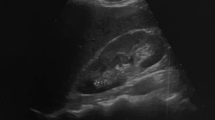Abstract
We determined whether the gravity effect of radiographic anatomic features on the preoperative urography (IVP) are enough to predict fragments clearance after shock wave lithotripsy (SWL). A Total of 282 patients with mean age 45.8 ± 13.2 years (189 male, 93 female), who underwent SWL due to renal calculi between October 2005 and August 2009 were enrolled. The mean calculi load was 155.72 ± 127.66 mm². The patients were stratified into three groups: patients with pelvis calculi (group 1); patients with upper or middle pole calculi (group 2) and patients with lower pole calculi (group 3). Three angles on the pretreatment IVP were measured: the inner angle between the axis of the lower pole infundibular and ureteropelvic axis (angle I); the inner angle between the lower pole infundibular axis and main axis of pelvis-ureteropelvic (UP) junction point (angle II) and the inner angle between the lower pole infundibular axis and perpendicular line (angle III). Multivariate analysis was used to define the significant predictors of stone clearance. The overall success rate was 85.81%. All angles, sessions number, shock waves number and stone burden were significant predictors of success in patients in group 1. However, in group 2 only angle II and in group 3 angles I and II had significant effect on stone clearance. Radiographic anatomic features have significant role in determining the stone-free rate following satisfactory fragmentation of renal stones with SWL. The measurement of infundibulopelvic angle in different manner helps to predict the stone-free status in patients with renal calculi located not only in lower pole, but also in renal pelvis and upper or middle pole. Gravity effect is not enough to justify the significant influence of the radiographic anatomic features on the stone clearance and fragments retention after SWL.

Similar content being viewed by others
References
Preminger GM (1995) Medical management of urinary calculus disease: pathogenesis and evaluation. AUA Update Series 14:1
Tiselius H, Alken P, Buck C, Galluci M, Gallucci M, Knoll T, Sarica K et al (2008) Guidelines on urolithiasis: active removal of stones in kidney. EUA Guidelines 7(6):47
Sampaio F, Aragao A (1992) Inferior pole collectiong system anatomy : its probable role in extracorporeal shock wave lithotripsy. J Urol 147:322–324
Sampaio FJB, Aragao AHM (1994) Limitations of extracorporeal shockwave lithotripsy for lower caliceal Stones: anatomic insight. J Endourol 8:241–247
Elbahnasy AM, Shalhav AL, Hoenig DM, Maxwell KL, McDougall EM, Clayman RV (1998) Lower caliciel stone clearence after shock wave lithotripsy or ureteroscopy: the impact of lower pole radiographic anatomy. J Urol 159:676–682
Chaussy C, Schmiedt E, Jocham D, Brendel W, Forssmann B, Walther V (1982) First clinical experience with extra corporeally induced destruction of kidney stones by shock waves. J Urol 127:417–420
Gupta NP, Singh DV, Hemal AK, Mandal S (2000) Infundibulopelvic anatomy and clearance of inferior caliceal calculi with shock wave lithotripsy. J Urol 163:24–27
Keeley FX Jr, Moussa SA, Smith G, Tolley DA (1996) Clearance of lower-pole Stones following shock wave lithotripsy: effect of the infundibulopelvic angle. Eur Urol 36:371–375
Abdel-Khalek M, Sheir KZ, Mokhtar AA, Eraky I, Kenawy M, Bazeed M (2004) Prediction of success rate after extracorporeal shock-wave lithotripsy of renal stones–a multivariate analysis model. Scand J Urol Nephrol 38(2):161–167
Sampaio FJ (2001) Renal collecting system anatomy: its possible role in the effectiveness of renal stone treatment. Curr Opin Urol 11(4):359–366
Sabnis RB, Naik PatelSH, Desai MR, Bapat SD (1997) Extracorporeal shockwave lithotripsy for lower calyceal Stones: can clearance be predicted? Br J Urol 80:853–857
Lingeman JE, Siegel YI, Steele B, Nyhuis AW, Woods JR (1994) Management of lower pole nephrolithiasis: a critical analysis. J Urol 151:663–667
Al-Ansari A, As-Sadiq K, Al-Said S, Younis N, Jaleel OA, Shokeir AA (2006) Prognostic factors of success of extracorporeal shock wave lithotripsy (ESWL) in the treatment of renal stones Int. Urol Nephrol 38(1):63–67
Tan MO, Kirac M, Onaran M, Karaoglan U, Deniz N, Bozkirli I (2006) Factors affecting the success rate of extracorporeal shock wave lithotripsy for renal calculi in children. Urol Res 34(3):215–221
El-Assmy, El-Nahas AR, Abo-Elghar ME, Eraky I, El-Kenawy MR, Sheir KZ (2006) Predictors of success after extracorporeal shock wave lithotripsy (ESWL) for renal calculi between 20–30 mm: a multivariate analysis model. ScientificWorldJournal 23(6):2388–2395
Sameh WM (2007) Value of intravenous urography before shockwave lithotripsy in the treatment of renal calculi: a randomized study. J End Urol 21(6):574–577
Author information
Authors and Affiliations
Corresponding author
Rights and permissions
About this article
Cite this article
Mustafa, M. Is the gravity effect of radiographic anatomic features enough to justify stone clearance or fragments retention following extracorporeal shock wave lithotripsy (SWL). Urol Res 40, 339–344 (2012). https://doi.org/10.1007/s00240-011-0412-8
Received:
Accepted:
Published:
Issue Date:
DOI: https://doi.org/10.1007/s00240-011-0412-8




